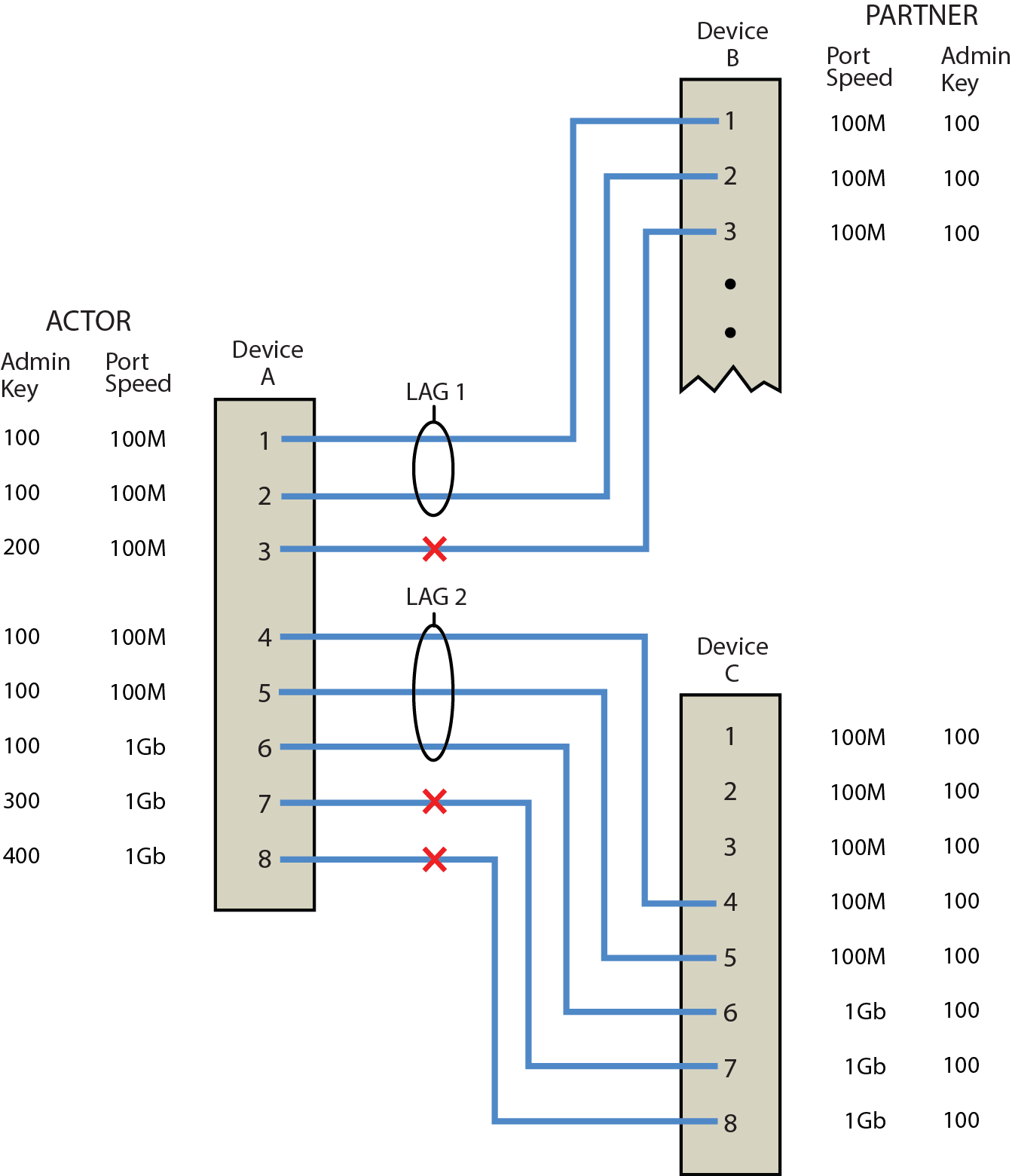How a LAG Forms
LAGs form automatically with LACP enabled on the device. There are four criteria for forming a LAG. Both actor and partner ports must:
- Operate in full duplex mode.
- Have matching local LAG and physical port admin keys for the device controlling LAG formation.
- Operate in parallel in that a LAG can have only two devices associated with it.
- Consist of two or more physical actor to partner port pairings unless the single port LAG feature is enabled.
LAG Formation displays a LAG formation example containing three devices with five 100Mbps ports and three 1Gb ports configured. For this example, all ports are operating in full-duplex mode, and the admin key for all LAG ports has been set to 100. Device A is the actor and therefore determines which ports will join a LAG. Devices B and C are the partners.
In our example two LAGs have formed because the actor ports are shared between two partner devices. Attempting to form a single LAG using all the actor ports would have broken the rule that actor and partner ports must operate in parallel.
Actor ports 1 - 3 on
device A directly connect to partner ports 1 - 3 on device B:
- We have already
stated that all ports are operating in full-duplex mode, so rule 1 is satisfied for all
three ports.
- Investigating the
port admin keys, we see that ports 1 and 2 on device A are set to 100 (the same setting
as all LAG ports on the device), while port 3 on device A is set to 200. Because the
port admin keys are the same for both the LAG port and these physical ports, ports 1 and
2 satisfy rule 2. Because the admin key for physical port 3 is different from any
possible LAG for this device, port 3 can not be part of any LAG.
- Because ports 1 and
2 for both the actor and partner operate in parallel with each other, rule 3 is
satisfied for these ports.
- Rule 4 is
satisfied, regardless of whether single port LAGs are enabled, because there are two
aggregatable port pairings between devices A and B.
For these reasons, LAG 1
(lag.0.1) is formed using actor and partner ports 1 and 2.
Actor ports 4 - 8 on
device A directly connect to partner ports 4 - 8 on device C:
- Because all ports
are operating in full-duplex mode, rule one is satisfied for all five ports.
- Investigating port
admin keys, we see that ports 4 - 6 on device A are set to 100 (the same setting as all
LAG ports on the device), while ports 7 and 8 on device A are set to 300 and 400,
respectively. Because port admin keys for all LAGs and the physical ports 4 - 6 are the
same, physical ports 4 - 6 satisfy rule 2. Because the admin key settings for physical
ports 7 and 8 do not agree with any LAG admin key setting on the device, ports 7 and 8
can not be part of any LAG.
- Because ports 4 - 6
for both the actor and partner operate in parallel with each other, rule 3 is satisfied
for these ports.
- Rule 4 is
satisfied, regardless of whether single port LAG is enabled, because there are three
aggregatable port pairings between devices A and C.
For these reasons, LAG 2
is formed using actor and partner ports 4 - 6.

Note
Port
speed is not a consideration in the forming phase for LAGs. LAG 2 contains 100Mbps and 1Gb
port members.



 Print
this page
Print
this page Email this topic
Email this topic Feedback
Feedback